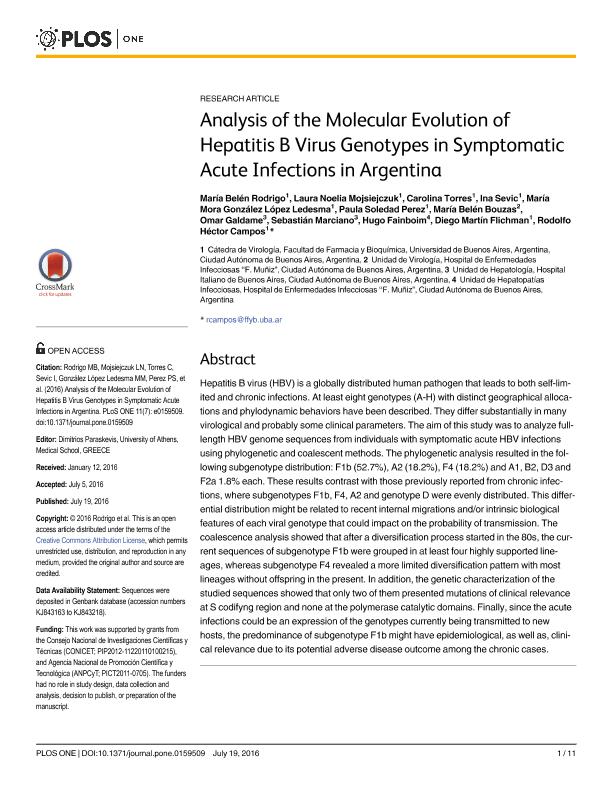Artículo
Analysis of the molecular evolution of hepatitis B virus genotypes in symptomatic acute infections in Argentina
Rodrigo, Maria Belen; Mojsiejczuk, Laura Noelia ; Torres, Carolina
; Torres, Carolina ; Sevic, Ina
; Sevic, Ina ; González López Ledesma, María Mora
; González López Ledesma, María Mora ; Pérez, Paula Soledad
; Pérez, Paula Soledad ; Bouzas, María Belén; Galdame, Omar; Marciano, Sebastián; Fainboim, Hugo; Flichman, Diego Martin
; Bouzas, María Belén; Galdame, Omar; Marciano, Sebastián; Fainboim, Hugo; Flichman, Diego Martin ; Campos, Rodolfo Hector
; Campos, Rodolfo Hector
 ; Torres, Carolina
; Torres, Carolina ; Sevic, Ina
; Sevic, Ina ; González López Ledesma, María Mora
; González López Ledesma, María Mora ; Pérez, Paula Soledad
; Pérez, Paula Soledad ; Bouzas, María Belén; Galdame, Omar; Marciano, Sebastián; Fainboim, Hugo; Flichman, Diego Martin
; Bouzas, María Belén; Galdame, Omar; Marciano, Sebastián; Fainboim, Hugo; Flichman, Diego Martin ; Campos, Rodolfo Hector
; Campos, Rodolfo Hector
Fecha de publicación:
07/2016
Editorial:
Public Library of Science
Revista:
Plos One
e-ISSN:
1932-6203
Idioma:
Inglés
Tipo de recurso:
Artículo publicado
Clasificación temática:
Resumen
Hepatitis B virus (HBV) is a globally distributed human pathogen that leads to both self-limited and chronic infections. At least eight genotypes (A-H) with distinct geographical allocations and phylodynamic behaviors have been described. They differ substantially in many virological and probably some clinical parameters. The aim of this study was to analyze full-length HBV genome sequences from individuals with symptomatic acute HBV infections using phylogenetic and coalescent methods. The phylogenetic analysis resulted in the following subgenotype distribution: F1b (52.7%), A2 (18.2%), F4 (18.2%) and A1, B2, D3 and F2a 1.8% each. These results contrast with those previously reported from chronic infections, where subgenotypes F1b, F4, A2 and genotype D were evenly distributed. This differential distribution might be related to recent internal migrations and/or intrinsic biological features of each viral genotype that could impact on the probability of transmission. The coalescence analysis showed that after a diversification process started in the 80s, the current sequences of subgenotype F1b were grouped in at least four highly supported lineages, whereas subgenotype F4 revealed a more limited diversification pattern with most lineages without offspring in the present. In addition, the genetic characterization of the studied sequences showed that only two of them presented mutations of clinical relevance at S codifyng region and none at the polymerase catalytic domains. Finally, since the acute infections could be an expression of the genotypes currently being transmitted to new hosts, the predominance of subgenotype F1b might have epidemiological, as well as, clinical relevance due to its potential adverse disease outcome among the chronic cases.
Palabras clave:
Hepatitis B Virus Genotypes
,
Acute Infections
Archivos asociados
Licencia
Identificadores
Colecciones
Articulos(OCA HOUSSAY)
Articulos de OFICINA DE COORDINACION ADMINISTRATIVA HOUSSAY
Articulos de OFICINA DE COORDINACION ADMINISTRATIVA HOUSSAY
Citación
Rodrigo, Maria Belen; Mojsiejczuk, Laura Noelia; Torres, Carolina; Sevic, Ina; González López Ledesma, María Mora; et al.; Analysis of the molecular evolution of hepatitis B virus genotypes in symptomatic acute infections in Argentina; Public Library of Science; Plos One; 11; 7; 7-2016; 1-11; e0159509
Compartir
Altmétricas



